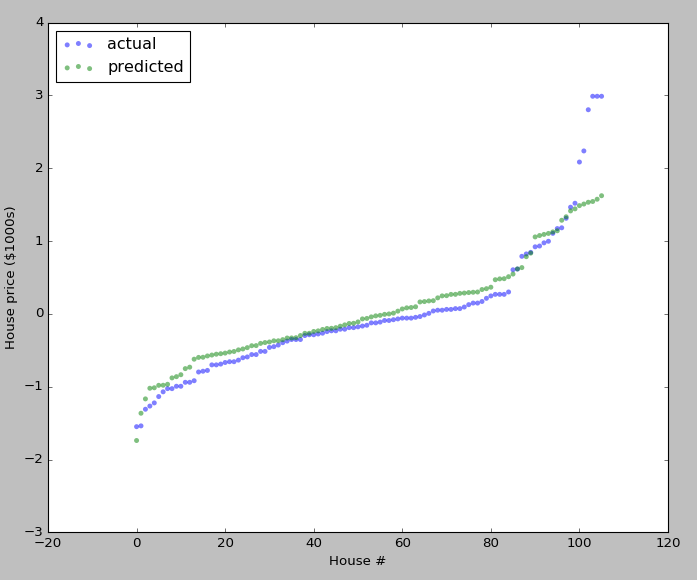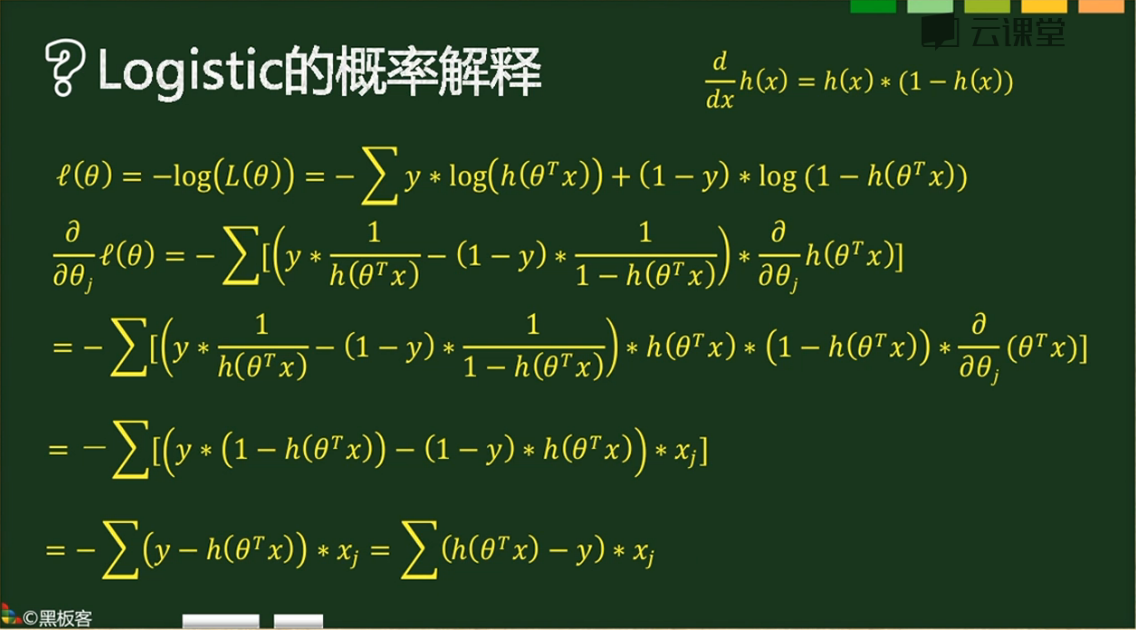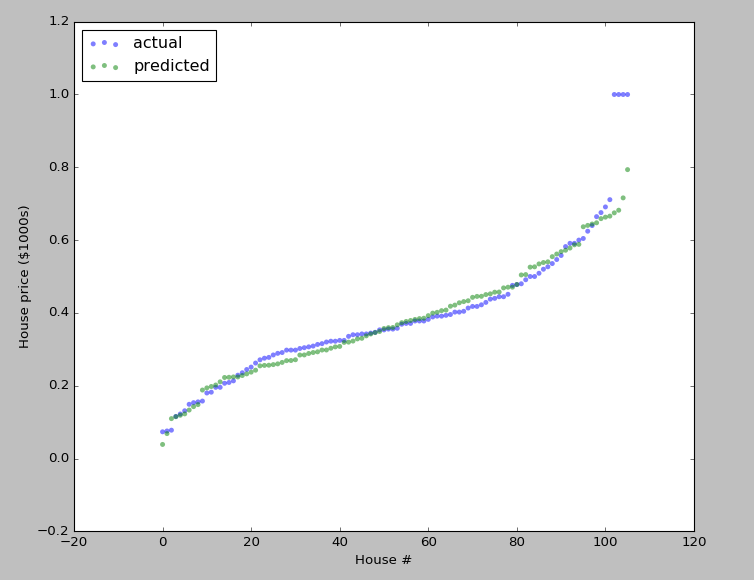sklearn线性回归模型
import numpy as np
import matplotlib.pyplot as plt
from sklearn import linear_model
def get_data():
#506行,14列,最后一列为label,前面13列为参数
data_original = np.loadtxt('housing.data')
scale_data = scale_n(data_original)
np.random.shuffle(scale_data)
#在位置0,插入一列1,axis=1代表列,代表b
data = np.insert(scale_data, 0, 1, axis=1)
train_X = data[:400, :-1] #前400行为训练数据
train_y = data[:400, -1]
train_y.shape = (train_y.shape[0],1)
test_X = data[400:, :-1]
test_y = data[400:, -1]
test_y.shape = (test_y.shape[0],1)
# test测试数据没有返回
return train_X,train_y,test_X,test_y
def scale_n(x):
return (x-x.mean(axis=0))/x.std(axis=0)
if __name__=="__main__":
train_X,train_y,test_X,test_y = get_data()
l_model = linear_model.Ridge(alpha = 1000) # 参数是正则化系数
l_model.fit(train_X,train_y)
predict_train_y = l_model.predict(train_X)
predict_train_y.shape = (predict_train_y.shape[0],1)
error = (predict_train_y-train_y)
rms_train = np.sqrt(np.mean(error**2, axis=0))
predict_test_y = l_model.predict(test_X)
predict_test_y.shape = (predict_test_y.shape[0],1)
error = (predict_test_y-test_y)
rms_test = np.sqrt(np.mean(error**2, axis=0))
print (rms_train, rms_test)
plt.figure(figsize=(10, 8))
plt.scatter(np.arange(test_y.size), sorted(test_y), c='b', edgecolor='None', alpha=0.5, label='actual')
plt.scatter(np.arange(test_y.size), sorted(predict_test_y), c='g', edgecolor='None', alpha=0.5, label='predicted')
plt.legend(loc='upper left')
plt.ylabel('House price ($1000s)')
plt.xlabel('House #')
plt.show()
sklearn模型调用民工三连:
l_model = linear_model.Ridge(alpha = 1000) # 模型装载
l_model.fit(train_X,train_y) # 模型训练
predict_train_y = l_model.predict(train_X) # 模型预测
手动线性回归模型
数据获取
房价数据,506行,14列,最后一列为label,前面13列为参数

假如我们需要平方特征,只要修改get_data()中的data_original即可,在13列后添加平方项或者立方项等,由于我们不知道具体添加多少特征的组合更好,神经网络自动提取组合特征的功能就被很好的凸显出来了
import numpy as np
import matplotlib.pyplot as plt
def get_data():
#506行,14列,最后一列为label,前面13列为参数
data_original = np.loadtxt('housing.data') # 读取数据
scale_data = scale_n(data_original) # 归一化处理
np.random.shuffle(scale_data) # 打乱顺序
#在位置0,插入一列1,axis=1代表列,代表b
data = np.insert(scale_data, 0, 1, axis=1) # 数组插入函数
train_X = data[:400, :-1] #前400行为训练数据
train_y = data[:400, -1]
train_y.shape = (train_y.shape[0],1)
test_X = data[400:, :-1]
test_y = data[400:, -1]
test_y.shape = (test_y.shape[0],1)
# test测试数据没有返回
return train_X,train_y,test_X,test_y
其中:
np.loadtxt('housing.data') # 读取数据
# 本函数读取数据后自动转化为ndarray数组,可以自行设定分隔符delimiter=","
np.insert(scale_data, 0, 1, axis=1) # 数组插入函数
# 在数组中插入指定的行列,numpy.insert(arr, obj, values, axis=None)
# 和其他数组一样,axis不设定的话会把数组定为一维后插入,axis=0的话行扩展,axis=1的话列扩展
预处理
中心归零,标准差归一
def scale_n(x):
"""
减去平均值,除以标准差
"""
x = (x - np.mean(x,axis=0))/np.std(x,axis=0)
return x
线性回归类
class LinearModel():
def __init__(self,learn_rate=0.06,lamda=0.01,threhold=0.0000005):
"""
初始化一些参数
"""
self.learn_rate = learn_rate # 学习率
self.lamda = lamda # 正则化系数
self.threhold = threhold # 迭代阈值
def get_cost_grad(self,theta,X,y):
"""
计算代价cost和梯度grad
"""
y_pre = X.dot(theta)
cost = (y_pre-y).T.dot(y_pre-y) + self.lamda*theta.T.dot(theta)
grad = (2.0*X.T.dot(y_pre-y) + 2.0*self.lamda*theta)/X.shape[0] # 实际上是1个batch的梯度的累加值
return cost, grad
def grad_check(self,X,y):
"""
梯度检查: 函数计算梯度 == L(theta+delta)-L(theta-delta) / 2delta
"""
m,n = X.shape
delta = 10**(-4)
sum_error = 0
for i in range(100):
theta = np.random.random((n,1))
j = np.random.randint(1,n)
theta1,theta2 = theta.copy(),theta.copy()
theta1[j] += delta
theta2[j] -= delta
cost1, grad1 = self.get_cost_grad(theta1, X, y)
cost2, grad2 = self.get_cost_grad(theta2, X, y)
cost, grad = self.get_cost_grad(theta , X, y)
sum_error += np.abs(grad[j] - (cost1-cost2)/(delta*2))
print(sum_error/300.0)
def train(self,X,y):
"""
初始化theta
训练后,将theta保存到实例变量里
"""
m,n = X.shape
theta = np.random.random((n,1))
prev_cost = None
for loop in range(1000):
cost,grad = self.get_cost_grad(theta,X,y)
theta -= self.learn_rate*grad
if prev_cost:
if prev_cost - cost < self.threhold:
break
prev_cost = cost
self.theta = theta
# print(theta,loop,cost)
def predict(self,X):
"""
预测程序
"""
return X.dot(self.theta)
主函数
if __name__ == "__main__":
train_X,train_y,test_X,test_y = get_data()
linear_model = LinearModel()
linear_model.grad_check(train_X,train_y)
linear_model.train(train_X,train_y)
predict_train_y = linear_model.predict(train_X)
error = (predict_train_y - train_y)
rms_train = np.sqrt(np.mean(error ** 2,axis=0))
predict_test_y = linear_model.predict(test_X)
error = (predict_test_y - test_y)
rms_test = np.sqrt(np.mean(error ** 2,axis=0))
#
print(rms_train,rms_test)
# [ 0.54031084] [ 0.60065021]
plt.figure(figsize=(10,8))
plt.scatter(np.arange(test_y.size),sorted(test_y),c='b',edgecolor='None',alpha=0.5,label='actual')
plt.scatter(np.arange(test_y.size),sorted(predict_test_y),c='g',edgecolor='None',alpha=0.5,label='predicted')
plt.legend(loc='upper left')
plt.ylabel('House price ($1000s)')
plt.xlabel('House #')
plt.show()

Logistic回归
数据获取&预处理
logistic回归输出值在0~1之间,所以数据预处理分两部分,前13列仍然是均值归零标准差归一,label列采取(x-x.min(axis=0))/(x.max(axis=0)-x.min(axis=0))的方式
import numpy as np
import matplotlib.pyplot as plt
import math
def get_data(N=400):
#506行,14列,最后一列为label,前面13列为参数
data_original = np.loadtxt('housing.data')
scale_data = np.zeros(data_original.shape)
scale_data[:,:13] = scale_n(data_original[:,:13])
scale_data[:,-1] = scale_max(data_original[:,-1])
np.random.shuffle(scale_data)
#在位置0,插入一列1,axis=1代表列,代表b
data = np.insert(scale_data, 0, 1, axis=1)
train_X = data[:N, :-1] #前400行为训练数据
train_y = data[:N, -1]
train_y.shape = (train_y.shape[0],1)
test_X = data[N:, :-1]
test_y = data[N:, -1]
test_y.shape = (test_y.shape[0],1)
# test测试数据没有返回
return train_X,train_y,test_X,test_y
def scale_n(x):
return (x-x.mean(axis=0))/x.std(axis=0)
def scale_max(x):
print (x.min(axis=0))
print (x.max(axis=0))
print (x.mean(axis=0))
print (x.std(axis=0))
return (x-x.min(axis=0))/(x.max(axis=0)-x.min(axis=0))
Logistic回归类
公式参考,

实际代码,
class LogisticModel(object):
def __init__(self,lamda=0.01, alpha=0.6,threhold=0.0000005):
self.alpha = alpha
self.threhold = threhold
self.lamda = lamda
def sigmoid(self,x):
return 1.0/(1+np.exp(-x))
def get_cost_grad(self,theta,X,y):
m, n = X.shape
y_dash = self.sigmoid(X.dot(theta))
error = np.sum((y * np.log(y_dash) + (1-y) * np.log(1-y_dash)),axis=1)
cost = -np.sum(error, axis=0)+self.lamda*theta.T.dot(theta)
grad = X.T.dot(y_dash-y)+2.0*self.lamda*theta
return cost,grad/m
def grad_check(self,X,y):
epsilon = 10**-4
m, n = X.shape
sum_error=0
for i in range(300):
theta = np.random.random((n, 1))
j = np.random.randint(1,n)
theta1=theta.copy()
theta2=theta.copy()
theta1[j]+=epsilon
theta2[j]-=epsilon
cost1,grad1 = self.get_cost_grad(theta1,X,y)
cost2,grad2 = self.get_cost_grad(theta2,X,y)
cost3,grad3 = self.get_cost_grad(theta,X,y)
sum_error += np.abs(grad3[j]-(cost1-cost2)/float(2*epsilon))
def train(self,X,y):
m, n = X.shape # 400,15
theta = np.random.random((n, 1)) #[15,1]
#our intial prediction
prev_cost = None
loop_num = 0
while(True):
#intial cost
cost,grad = self.get_cost_grad(theta,X,y)
theta = theta- self.alpha * grad
loop_num+=1
if loop_num%100==0:
print (cost,loop_num)
if prev_cost:
if prev_cost - cost <= self.threhold:
break
if loop_num>1000:
break
prev_cost = cost
self.theta = theta
print (theta,loop_num)
def predict(self,X):
return self.sigmoid(X.dot(self.theta))
